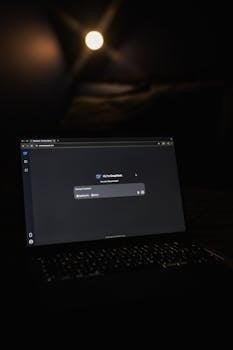PowerFlex 755 Fault Codes PDF⁚ An Overview
The PowerFlex 755 drive is a versatile tool, but like all complex systems, it can encounter faults. This overview introduces PowerFlex 755 fault codes, crucial for efficient troubleshooting and maintenance, often found in PDF manuals.

Understanding PowerFlex 755 Fault Codes
Delving into PowerFlex 755 fault codes requires understanding their structure and purpose. These codes provide valuable diagnostic information, aiding technicians in quickly identifying issues within the PowerFlex 755 system and implementing effective solutions.
Fault Code Display Formats
PowerFlex 750-Series faults and alarms present event numbers in different formats. On Port 00 (Host Drive), only the event number is displayed. For example, “Fault 3 Power Loss” appears as “Fault Code 3.” Other ports may show a combined code, like “14037” for “Fault 37 Net IO Timeout” on Port 14, where the initial digits represent the port number.
Understanding this format is vital for quickly diagnosing issues. Dual Incremental Encoder faults, such as “Enc1 Open Wire,” also follow a specific display format, often referencing tables in the programming manual. The display assists in identifying the location and type of the issue. Recognizing these display variations ensures accurate interpretation and troubleshooting.
Importance of Fault Code Documentation
Fault code documentation for PowerFlex 755 drives is crucial for efficient troubleshooting and maintenance. Proper documentation provides a comprehensive understanding of each fault, its potential causes, and recommended corrective actions. Without it, diagnosing issues becomes time-consuming, relying on guesswork rather than informed decisions.
Detailed manuals and guides explain the meaning behind each code, enabling technicians to quickly identify the root cause of a problem. This reduces downtime and minimizes production losses. Furthermore, consulting the documentation ensures that repairs are carried out correctly, preventing further damage to the drive or connected equipment. Accessing and understanding these resources is essential for maintaining the optimal performance and longevity of PowerFlex 755 systems.

Common PowerFlex 755 Fault Codes and Troubleshooting
This section covers common PowerFlex 755 fault codes, offering insights into causes and troubleshooting. Understanding these codes is vital for effective maintenance and reducing downtime in industrial applications.
Net I/O Timeout Fault (4037)
The Net I/O Timeout fault, often displayed as code 4037, indicates a communication issue between the PowerFlex 755 drive and the control network. This commonly occurs in CompactLogix systems where PowerFlex drives communicate via Ethernet. If the drive doesn’t receive I/O data within the expected timeframe, this fault is triggered, potentially halting operations.
Possible causes include network congestion, faulty Ethernet cables, incorrect IP configurations, or issues with the PLC’s communication settings. Troubleshooting involves verifying network connectivity, checking cable integrity, and ensuring that the PLC and drive are correctly configured and communicating.
Reviewing the network’s configuration and updating firmware can also help resolve this issue. Sometimes, the fault clears immediately after resetting, but persistent issues require deeper investigation into the network’s stability.
Safety Jumper In Fault (F213)
The Safety Jumper In Fault, indicated by code F213, signifies that the SAFETY jumper is improperly installed or absent when it should be removed. This fault is crucial because it relates to the drive’s safety functions. Certain PowerFlex 755 drives, particularly frames 810, do not utilize a SAFETY jumper on their control boards.
If a jumper is present on these models, the F213 fault will occur, preventing the drive from operating. The jumper must be removed to clear the fault. Conversely, if the jumper is required but missing or incorrectly placed, it can also trigger the fault.
Always consult the specific drive’s manual to determine the correct jumper configuration for safety circuits. Proper installation is paramount to ensuring the drive’s safe operation and avoiding unexpected shutdowns.
Transistor Overtemp Fault (F9)
The Transistor Overtemp Fault, designated as F9, indicates that the drive’s transistors have exceeded their maximum allowable temperature. This fault often arises from excessive load, inadequate cooling, or high ambient temperatures surrounding the drive. For PowerFlex 755 drives with firmware versions 1.009 and earlier, an F9 fault might occur during startup when initiating large torques from zero speed in Sensorless Vector mode.
Sensorless Vector, the default setting for P35, can contribute to this issue. To resolve the F9 fault, ensure proper ventilation and cooling of the drive. Verify that the motor load is within the drive’s specifications and consider reducing the load or optimizing acceleration and deceleration rates.
Updating the drive’s firmware to a later version may also mitigate this fault in specific applications.

PowerFlex 755 Specific Fault Scenarios
Certain faults are more likely to occur in specific operational scenarios. Understanding these common PowerFlex 755 fault codes in these situations can expedite troubleshooting and minimize downtime, particularly within complex industrial applications.
Faults During Startup
Startup is a critical phase for PowerFlex 755 drives, and various faults can surface during this initial operation. One common issue involves safety jumpers; the absence of a SAFETY jumper removal can trigger a Safety Jumper In fault (F213). However, it’s important to note that PowerFlex 755 drives (frames 810) control boards lack a SAFETY jumper.
Another potential cause is firmware-related. Older firmware versions (1.009 and earlier) may exhibit fault F9 (transistor overtemp) when starting into large torques from zero speed, especially in Sensorless Vector mode. Addressing these startup faults promptly is crucial to avoid extended downtime. This is often documented in the PowerFlex 755 manuals.
Faults Related to Motor Load
Motor load is a significant factor influencing PowerFlex 755 drive performance. A common fault related to motor load is Drive Overload, triggered when the drive’s overload rating is exceeded. This occurs when the motor experiences excessive load or demand surpassing its rated capacity.
Another load-related fault is Ground Fault, which arises when a current path to earth ground is detected at one or more of the drive output terminals. This usually indicates issues within the motor itself, such as insulation breakdown or winding damage. These faults are all preventable with correct motor sizing and understanding of the PowerFlex 755 manuals.

Using PowerFlex 755 Manuals for Fault Resolution
PowerFlex 755 manuals are indispensable for fault resolution, providing detailed fault code descriptions and troubleshooting steps. These resources are key to quickly identifying and addressing drive issues.
Accessing and Downloading Manuals
Accessing PowerFlex 755 manuals is a crucial step in fault resolution. These manuals often contain critical information related to the fault codes, troubleshooting procedures, and safety guidelines. The Rockwell Automation Literature Library is a primary source for downloading these manuals.
Typically, you can find these manuals on the Rockwell Automation website. Search for “PowerFlex 755 manuals” or specify the exact model number. Ensure you download the correct manual corresponding to your drive’s firmware version. Manuals are usually available in PDF format.
These PDFs can be saved for offline access, proving invaluable when troubleshooting in areas with limited or no internet connectivity. Having a downloaded manual ensures that you have immediate access to fault code information and resolution steps, expediting the repair process and minimizing downtime.
Navigating Fault Code Tables
Once you have acquired the PowerFlex 755 manual, efficiently navigating the fault code tables is essential. These tables provide a structured list of fault codes, their corresponding descriptions, potential causes, and recommended actions. Familiarize yourself with the table’s layout to quickly locate the relevant information.
Typically, the fault code is listed numerically or alphanumerically, followed by a brief description of the fault. Pay close attention to the “Possible Causes” section, which outlines the likely reasons for the fault. The “Recommended Actions” section provides step-by-step instructions to diagnose and resolve the issue.
Understanding the table’s structure allows you to rapidly interpret fault codes, identify potential causes, and implement the appropriate corrective measures, minimizing downtime and ensuring efficient troubleshooting.
Additional Resources for PowerFlex 755 Troubleshooting
Beyond manuals, leverage Rockwell Automation’s Literature Library for documentation. Explore online forums and communities; they offer invaluable insights, shared experiences, and collaborative problem-solving for PowerFlex 755 troubleshooting.
Rockwell Automation Literature Library
The Rockwell Automation Literature Library is an indispensable resource for troubleshooting PowerFlex 755 drives. It offers a wealth of documentation, including user manuals, installation guides, and technical specifications. You can access detailed information about fault codes, alarm conditions, and configurable parameters, enabling a deeper understanding of potential issues.
Within the library, you’ll find documents specific to the PowerFlex 755 series, covering various firmware revisions and hardware configurations. This ensures you have the most relevant information for your particular drive model. The literature often includes troubleshooting flowcharts and step-by-step instructions to diagnose and resolve common faults.
Furthermore, the library provides access to application notes and white papers that address specific challenges or advanced configurations. By exploring these resources, you can gain valuable insights into optimizing drive performance and preventing future faults. Regularly checking for updated documentation is crucial as firmware and hardware evolve.
Online Forums and Communities
Online forums and communities serve as valuable platforms for PowerFlex 755 users to share knowledge and troubleshoot issues collaboratively. These platforms offer a space to discuss specific fault codes, share experiences, and seek advice from experienced professionals. Engaging in these communities can provide practical solutions and alternative perspectives beyond standard documentation.
Users often post detailed descriptions of their encountered faults, along with relevant drive configurations and operating conditions. Other members can then offer suggestions based on their own experiences, potentially leading to quicker resolutions. These forums can also provide insights into less common fault scenarios not explicitly covered in manuals.
Furthermore, online communities often host discussions about best practices, firmware updates, and compatibility issues. Participating in these discussions can help you stay informed about the latest developments and potential challenges related to PowerFlex 755 drives. Remember to verify information from unofficial sources with official documentation whenever possible.
